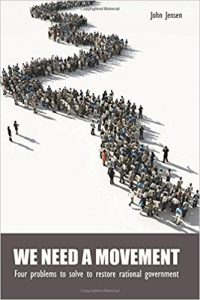How to Re-unite Society
 By John Jensen, Ph.D.
By John Jensen, Ph.D.
In a New York Times article in 2016, “How Republics End,” Paul Krugman summed up the breakdown of civic virtue in the Roman Empire that led to its downfall, and its parallels with conditions now. He concluded that he did not see any forces operating today that can prevent such a breakdown for us. Elites dominate, many are discouraged about change, and positive efforts are fractured. Many are helpless even to “get through” to people they know well and presume that “they are the problem” and “I just can’t talk them.” By accepting that as final and unchangeable, however, we face more fragmentation of society. Knowing full well that systemic problems cannot be solved that way, we are driven to find ways to collaborate even distastefully, reluctantly, or ruefully.
But in fact, a vast body of knowledge exists precisely about how to communicate and collaborate with people who either dismiss us or disagree with us. Taken together the fields of sales, psychotherapy, education, group dynamics, mediation, team building, public speaking, social change, politics, organizational development, and basic research contain an enormous resource of information on how to proceed. Most people’s way to get across an idea to someone who disagrees, instead, is just to say it either more times or louder or both; that should get through to them! History tells us, however, that under some conditions, change occurs swiftly. Commenting once on his efforts to form the United Farm Workers union, Cesar Chavez said, “Organizing is easy. Just paint a picture and color it in.”
In that brief statement are the components of today’s need.
First, a picture, a vision, “This is what we’re after.” It should be significant and beautiful enough to inspire people to want to expend energy to make it happen, while the US today labors under conflicting pictures united only by the principle, “Everyone for themselves.” We each try to take care of our own people and interest group, while those with power to do so gather even more resources for themselves and their interests. A goal that might unite at least a majority, on the other hand, is “the good of the whole.” It is like realizing that decorating our own lifeboat comes after making sure our ship floats. We need to be able to walk and chew gum at the same time, sustain a range of values simultaneously. Our immediate self-interest is only one value, and our human brain must remind us that many other values are ultimately important to us personally, to all humans, and to the natural world.
Second, “color it in.” This implies one person speaking the picture to another so it looks beautiful and makes sense. We can readily imagine Cesar Chavez talking to roomful of people—enthusiastic, practical, detailed, pointed—and establishing the relevance of the picture to their lives.
For ourselves, we need to understand the features and conditions of life today that threaten the very existence of our society, and the most direct means of changing them. Learning is involved. We can think of the picture we transmit as having the role toward society like a tree depends on an acorn. Think of the latter’s miracle. Somehow its molecular structure guides it in how to respond to all the conditions it encounters. Our picture of the society we want needs to have a comparable ability to arrange conditions it faces.
But absorbing and transmitting the picture and persisting at it long enough to bring about change depends on features that need to occur together: vision (the picture to transmit), learning (absorbing the picture ourselves), action (expressing it to others), and mutual support (hanging together to encourage each other’s efforts). These are the components of a movement. With every new person, we help them understand the picture, engage them in learning groups that are inspirational and competence-building, engage them in confident action expressing these ideas and with group campaigns and outreach, and “have their back” so they continually feel supported and energized.
 These conditions are easier to implement than most might think and can lead to rapid growth. Imagine gaining just one new person per month for your purpose—four weeks of you and your friend in study, learning, and action. Next month, you two find two more and four do the same, and in the third month, eight. At that slow pace of monthly doubling, however, in a year you become 2,048. The crux is each one really learning and committing to the picture and the process of sharing it, each one gaining “the acorn plan” within them that enables them to spread their ideas.
These conditions are easier to implement than most might think and can lead to rapid growth. Imagine gaining just one new person per month for your purpose—four weeks of you and your friend in study, learning, and action. Next month, you two find two more and four do the same, and in the third month, eight. At that slow pace of monthly doubling, however, in a year you become 2,048. The crux is each one really learning and committing to the picture and the process of sharing it, each one gaining “the acorn plan” within them that enables them to spread their ideas.
How to understand, develop, and apply these ideas is the subject of my recently published book, We Need a Movement: Four Problems to Solve to Restore Rational Government (available at Createspace.com/7601534). For an overview of its message and purpose, and a free download of the text, see also my website.









